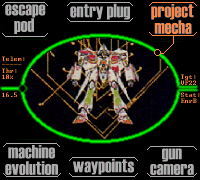
Why Mecha?
Power Systems
The Weapons of War
Control Systems
Real-world Projects
Back to Introduction
Get your own Free Home Page
Project Mecha
Propulsion and Locomotion
Walking
The seemingly simple task of walking involves shifting one's center of gravity while moving in a forward direction and taking into account imperfections of the terrain. With the aid of vision and the inner ear, humans are able to accomplish the precarious act of walking.Throwing the weight of several tons of walking metal requires a lot of minute real-time adjustments, so to make machines walk is no simple task. In high winds or water, a large structure such as a tank-like or larger mecha would have to contend with being severely buffeted around. This does not even take into account battle conditions, where projectiles and explosions produce kinetic forces that could literally blow a two-legged mecha off its heavy metal feet.
Much research has been done on the problem in the field of robotics, but the most recent research has shown greater success in making unusual contraptions hop (one of them resembles a pogo stick; it has only one leg) than in making legs simply copied from biological walking systems, and making them walk. If giant, tank-like mecha are to walk in the future, they may not resemble two-legged humans, but they may instead take more multi-legged, insectlike forms.
Flying
Mecha action is typically fast and furious, and this is more so in the air. The technology of Macross and Gundam somehow allow missiles and mecha to pull abrupt and physically-impossible vector changes. For real vehicles to even come close to the maneuverability inherent in anime mecha, engineers would first have to surmount the problems of inertia and structural strength.

The experimental YF-21, using vectored thrust and advanced control surfaces, easily outclassses and confronts the older VF-11 in midair in a scene taken from Macross Plus.
All of this precludes the discussion of a more important question, which is why try to propel the inherently un-aerodynamic human-shaped body through the atmosphere at all? Flight capability could greatly increase the range and flexibility of mecha, but it would simply be inefficient to fly a slab of heavy armor through atmosphere. While some directors choose to ignore this question outright, others do provide a way to solve the problem. In Macross, and more recently in The Vision of Escaflowne, airborne mecha transform into a shape better suited for flying in the air.
Space and Re-entry

Dream Pod 9's prelude to Heavy Gear, Jovian Chronicles, features space-capable exo-armor as standard equipment for both the Earth forces and the Colonists.
Entering and escaping atmosphere also present some problems for air and space superiority mecha. Lifting off alone requires a considerable amount of thrust, and rapidly escaping the pull of gravity (that is, flying into space vertically) requires even more thrust. Detachable booster rockets are employed in some cases, while some mecha universes use anti-gravity technology to allow mecha to ignore the problem of gravity. As for returning to an atmosphere, mecha are usually not even allowed to, relying instead on mother ships to enter and leave atmosphere. Some universes such as that of Battletech and Starship Troopers put mecha in ablative armor or re-entry cocoons that both make the mecha more aerodynamic and absorb much of the heat involved.
In real terms, NASA's reusable launch test vehicle, the X-33, will use an 'aerospike', a new kind of propulsion system which automatically adjusts itself to perform with high efficiency at varying altitudes, which means an aircraft can be made that is able to enter and leave the atmosphere without the use of the large, costly booster rockets that the Space Shuttle currently uses. Seeing military potential in an aerospike-equipped fighter, the Air Force Space Command, NASA and the Lockheed Martin Skunk Works are already considering specifications for the space fighter of 2025.
[Source: Virtualtech Issue 2]